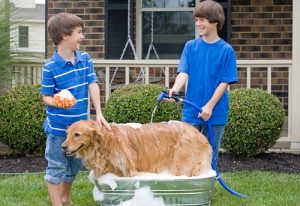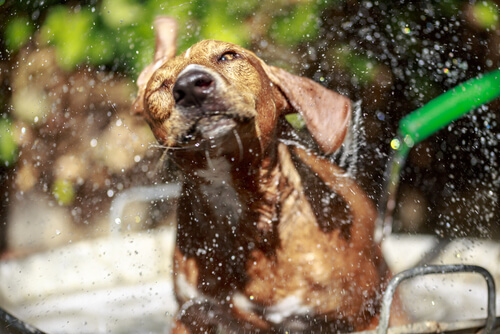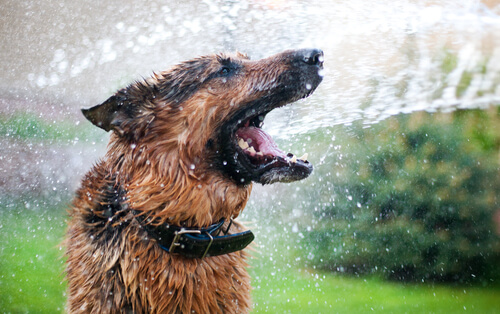Tips For Bathing Your Dog With A Garden Hose


Written and verified by the lawyer Francisco María García
The vast majority of dogs hate taking baths. However, you can take advantage of hot days to give your dog a bath with a garden hose, which will make it a lot easier.
Using a garden hose will especially make bath time easier when it comes to larger dogs. You just have to keep a few things in mind in order to do it well without having any issues.
Tips for Bathing your Dog with A Garden Hose
Preparation
First, you have to think about where in the yard you’re going to bathe your dog. Make sure there is a faucet nearby and check that the water isn’t too cold. Ideally, the water should be warm, so it’s best to wait for a very hot day.
If you prefer to bathe your dog inside your home, then you can use the tub or the shower head. This will make it easier to control the temperature.
Next, prepare everything you are going to need during the bath: shampoo for dogs with the lid open, towels, sponge, cloth and the dog’s collar to keep him from escaping. All of this needs to be in your reach.
Shampoo and Water Pressure
The shampoo needs to be suitable for your dog’s fur. You don’t want it to irritate his skin or mucous membranes. The shampoo’s perfume shouldn’t be too strong because it’ll bother your dog. If he doesn’t like it, he will just get dirty again in order to get rid of the smell.

It’s Best to Pick Out a Neutral Shampoo
The collar that you are using should be nylon. Leather shrinks when it dries, and it would tighten around your dog’s neck. So, make sure that his collar isn’t too tight.
It’s important to check the hose’s water pressure before you use it. If it’s too strong, your dog will get scared and try to run away. A good option is to use a shower head in order for it to be more enjoyable and effective.
Finally, you should place cotton balls in his ears to keep any water from getting in. They should be large enough to cover his ears well.
Bath
During his bath, avoid getting your dog’s head wet. It’s important to start by spraying the water on the back of his neck until his fur and legs are completely soaked. Use a sponge to scrub his body well.

You should wash each leg separately and carefully, as well as the stomach, groin and anal area. If the shampoo contains flea repellent, it must be left on for the time that’s indicated on the bottle.
It’ll be necessary to rinse the dog’s body until the water runs clear, without any traces of dirt or foam. To wash your dog’s face, it’s best to use a damp cloth; this will keep the water from getting in his ears and causing infection.
Drying
Use large towels that are good at absorbing liquids in order to dry your dog after bathing him with a garden hose. It’s necessary to wring out his hair if it’s long and start to dry him by placing the towel on his back. Avoid rubbing him when you’re drying him so you don’t create any knots in his fur.
Some dog owners prefer to use a hairdryer. If you do, make sure the air temperature is set either warm or cold to prevent burning your pet’s delicate skin. Once he’s dry, you should brush his fur so it doesn’t get tangled and get rid of any loose hairs.
Positive Reinforcement
While bathing your dog with a garden hose, remember to speak softly, don’t pull on his collar too much, and not be too aggressive. If everything goes well, and your dog had a successful bath, reward him with his favorite treat so he can associate bath time with a pleasant experience. With positive reinforcement, he won’t resist so much during his next bath.
How Often You Should Bathe Your Dog
How often you bathe your dog depends on his breed, size, length and type of fur, and the activities he does. If he spends a lot of time outdoors, you’ll want to bathe him more often than a dog that stays inside. In general, a bath is recommended every three months.
The vast majority of dogs hate taking baths. However, you can take advantage of hot days to give your dog a bath with a garden hose, which will make it a lot easier.
Using a garden hose will especially make bath time easier when it comes to larger dogs. You just have to keep a few things in mind in order to do it well without having any issues.
Tips for Bathing your Dog with A Garden Hose
Preparation
First, you have to think about where in the yard you’re going to bathe your dog. Make sure there is a faucet nearby and check that the water isn’t too cold. Ideally, the water should be warm, so it’s best to wait for a very hot day.
If you prefer to bathe your dog inside your home, then you can use the tub or the shower head. This will make it easier to control the temperature.
Next, prepare everything you are going to need during the bath: shampoo for dogs with the lid open, towels, sponge, cloth and the dog’s collar to keep him from escaping. All of this needs to be in your reach.
Shampoo and Water Pressure
The shampoo needs to be suitable for your dog’s fur. You don’t want it to irritate his skin or mucous membranes. The shampoo’s perfume shouldn’t be too strong because it’ll bother your dog. If he doesn’t like it, he will just get dirty again in order to get rid of the smell.

It’s Best to Pick Out a Neutral Shampoo
The collar that you are using should be nylon. Leather shrinks when it dries, and it would tighten around your dog’s neck. So, make sure that his collar isn’t too tight.
It’s important to check the hose’s water pressure before you use it. If it’s too strong, your dog will get scared and try to run away. A good option is to use a shower head in order for it to be more enjoyable and effective.
Finally, you should place cotton balls in his ears to keep any water from getting in. They should be large enough to cover his ears well.
Bath
During his bath, avoid getting your dog’s head wet. It’s important to start by spraying the water on the back of his neck until his fur and legs are completely soaked. Use a sponge to scrub his body well.

You should wash each leg separately and carefully, as well as the stomach, groin and anal area. If the shampoo contains flea repellent, it must be left on for the time that’s indicated on the bottle.
It’ll be necessary to rinse the dog’s body until the water runs clear, without any traces of dirt or foam. To wash your dog’s face, it’s best to use a damp cloth; this will keep the water from getting in his ears and causing infection.
Drying
Use large towels that are good at absorbing liquids in order to dry your dog after bathing him with a garden hose. It’s necessary to wring out his hair if it’s long and start to dry him by placing the towel on his back. Avoid rubbing him when you’re drying him so you don’t create any knots in his fur.
Some dog owners prefer to use a hairdryer. If you do, make sure the air temperature is set either warm or cold to prevent burning your pet’s delicate skin. Once he’s dry, you should brush his fur so it doesn’t get tangled and get rid of any loose hairs.
Positive Reinforcement
While bathing your dog with a garden hose, remember to speak softly, don’t pull on his collar too much, and not be too aggressive. If everything goes well, and your dog had a successful bath, reward him with his favorite treat so he can associate bath time with a pleasant experience. With positive reinforcement, he won’t resist so much during his next bath.
How Often You Should Bathe Your Dog
How often you bathe your dog depends on his breed, size, length and type of fur, and the activities he does. If he spends a lot of time outdoors, you’ll want to bathe him more often than a dog that stays inside. In general, a bath is recommended every three months.
This text is provided for informational purposes only and does not replace consultation with a professional. If in doubt, consult your specialist.








